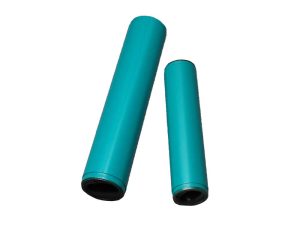The stator of a progressive cavity pump is mainly made of rubber. Because it needs to form a closed meshing cavity with the rotor, it is an interference fit with the rotor. When the rotor (main shaft) rotates and causes continuous friction, it will wear naturally.
Product Parameters
| Product Name | Stator |
| Material | NBR,HNBR,EPDM rubber,FKM,etc. |
What is a stator of a progressive cavity pump?
The stator of the progressive cavity pump is one of the essential main parts of the progressive cavity pump, also known as the progressive cavity pump bushing;

The material is usually divided into two categories:
1. Use inelastic hard materials such as metals, plastics, and ceramics;
2. Use rubber-like elastic materials (including a small amount of elastic-plastic).
At present, most stators of a progressive cavity pump are rubber-based stators;
The rotor, driven by the external power source, meshes with the stator to form a sealed cavity that separates the suction cavity and the discharge cavity so that the pump can work effectively.
Table A – Physical properties of rubber
| Performance | Natural rubber (NR) | Nitrile rubber (NBR) | Chloroprene rubber (CR) | Butyl rubber (IIR) | EPDM | Chlorinated polyethylene (CSM) | Chlorohydrin glue (CHR) | Acrylic resin glue (ACM) | Chlorinated rubber (EPM) | Polyurethane rubber (Pu) |
|---|---|---|---|---|---|---|---|---|---|---|
| Vulcanized rubber hardness [Shore (A)] | 30 ~ 95 | 30 ~ 100 | 40 ~ 90 | 40 ~ 85 | 30 ~ 85 | 50 ~ 95 | 40 ~ 90 | 60 ~ 80 | 60 ~ 80 | > 30 |
| Tensile strength /Mpa | < 18 | < 20 | < 20 | < 16 | < 20 | < 16 | < 18 | < 13 | < 12 | < 40 |
| Operating temperature range /℃ | -55 ~ 100 | -30 ~ 120 | -20 ~ 120 | -40 ~ 150 | -50 ~ 150 | -30 ~ 125 | -40 ~ 150 | -20 ~ 200 | -20 ~ 250 | -20 ~ 80 |
| Elongation | ● | ○ | ● | △ | ○ | ○ | ○ | △ | ○ | ● |
| Elasticity | ● | ○ | ○ | × | ○ | △ | ○ | ○ | △ | ● |
| Compression set resistance | ● | ● | ○ | △ | ○ | ○ | △ | ● | ● | ● |
| Tear resistance | ● | ○ | ○ | ○ | ○ | ○ | ○ | ○ | ○ | ● |
| Wear resistance | ● | ● | ○ | △ | ○ | ○ | ○ | ● | ● | ● |
| Aging resistance | △ | ○ | ○ | ● | ● | ● | ● | ○ | ● | △ |
| Flexibility | ● | ○ | ● | ● | ○ | ● | ○ | △ | ● | ● |
| Heat resistance | △ | ○ | ○ | ● | ● | ○ | ● | ● | ● | △ |
| Water resistance | ● | ○ | ● | ● | ● | ● | ● | × | ● | × |
| Dynamic characteristics | ● | ○ | △ | × | ○ | △ | ○ | ○ | △ | ● |
| Best performance | Good elasticity, high strength, good low temperature performance and optimal dynamic performance | Turbidity and heat resistance | Acid and alkali resistance, water resistance, ozone resistance, self extinguishing | Water resistance, steam resistance, good air tightness | Aging resistance, chemical resistance, insulation, temperature resistance | Aging resistance, ozone resistance, chemical resistance | Heat resistance, cold resistance, good solvent resistance | High temperature resistant oil, halogen resistant, heat resistant | High temperature resistance, excellent media resistance | Optimal wear resistance, high lightness, high elasticity |
Note: ●: Excellent performance ○: Good performance △: Poor performance ×: Very poor performance
Table B – Rubber’s media resistance table
| Material | Maximum temperature | Suitable media | Unsuitable media |
|---|---|---|---|
| Natural rubber (NR) | 70 ℃ | The mixture of abrasive substances, a mixed liquid of organic matter, acid, alcohol, acetaldehyde, mud, cement slurry, cement | Ozone, concentrated acids, fats, oils, hydrocarbons (methane, ethylene, benzene) |
| Nitrile rubber (NBR) | 90 ℃ | Hydrocarbons, weak acids, weak bases, light gasoline, mineral oils, animal and vegetable oils, fats, lubricants | Aromatic hydrocarbons (substances with benzene), chlorohydrocarbons, esters, acetaldehydes, ketones, ozone, strong acids |
| Chloroprene rubber (CR) | 90 ℃ | Ozone, fat, paraffin-based lubricating oil, volatile lubricating oil, fatty hydrocarbon, reducing agent, salt solution | Strong acids, ketones, esters, aromatic hydrocarbons, chlorohydrocarbons, aromatic lubricants, acetic acid |
| Fluorosulfonylated polyethylene glue | 110 ℃ | Alcohol, salt solution, ammonia, acid chemicals, oil, bleach, disinfectant, paper, mud, chromic acid | Strong acid, crude oil, tar, aromatic carbon compound, chlorohydrocarbon |
| Fluororubber (EPM) | 180 ℃ | Aliphatic hydrocarbons, aromatic hydrocarbons, halogen hydrocarbons, oils, fats, acids | Ketones, esters |
| Ethylene | 110 ℃ | Ozone, hot water, strong sulfuric acid, nitric acid, animal and vegetable oils, fats | Petroleum, solvent, benzene, aromatic hydrocarbon, light oil, tar |
| Chloroprene rubber (VE) | 120 ℃ | Mineral oil (high temperature), animal and vegetable food oil, latex, rubber, paste-like solvent | Water, aromatic hydrocarbons, alcohol, ketones, alkalis, acids |
| Sodium rubber | 80 ℃ | Sewage, abrasive material mixed liquid, acid sludge, ammonia, inorganic sewage mixed liquid | Same as natural rubber, other ketones and fats |
| Butyl rubber (IIR) | 110 ℃ | Animal and vegetable oils, oils, fats, ozone, strong acidification drugs, acids, alkalis | Petroleum, solvents, benzene, aromatic hydrocarbons, light gasoline, lubricating oil |
